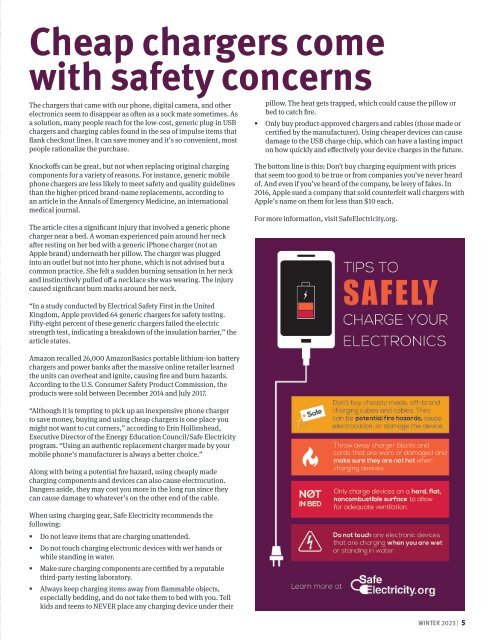Winter 2023 Generator
Learn more about our EnergyWise programs, a change in rates and the Board of Directors for 2023, and cell charger safety.
Learn more about our EnergyWise programs, a change in rates and the Board of Directors for 2023, and cell charger safety.
You also want an ePaper? Increase the reach of your titles
YUMPU automatically turns print PDFs into web optimized ePapers that Google loves.
Cheap chargers come<br />
with safety concerns<br />
The chargers that came with our phone, digital camera, and other<br />
electronics seem to disappear as often as a sock mate sometimes. As<br />
a solution, many people reach for the low-cost, generic plug-in USB<br />
chargers and charging cables found in the sea of impulse items that<br />
flank checkout lines. It can save money and it’s so convenient, most<br />
people rationalize the purchase.<br />
Knockoffs can be great, but not when replacing original charging<br />
components for a variety of reasons. For instance, generic mobile<br />
phone chargers are less likely to meet safety and quality guidelines<br />
than the higher-priced brand-name replacements, according to<br />
an article in the Annals of Emergency Medicine, an international<br />
medical journal.<br />
The article cites a significant injury that involved a generic phone<br />
charger near a bed. A woman experienced pain around her neck<br />
after resting on her bed with a generic iPhone charger (not an<br />
Apple brand) underneath her pillow. The charger was plugged<br />
into an outlet but not into her phone, which is not advised but a<br />
common practice. She felt a sudden burning sensation in her neck<br />
and instinctively pulled off a necklace she was wearing. The injury<br />
caused significant burn marks around her neck.<br />
pillow. The heat gets trapped, which could cause the pillow or<br />
bed to catch fire.<br />
• Only buy product-approved chargers and cables (those made or<br />
certified by the manufacturer). Using cheaper devices can cause<br />
damage to the USB charge chip, which can have a lasting impact<br />
on how quickly and effectively your device charges in the future.<br />
The bottom line is this: Don’t buy charging equipment with prices<br />
that seem too good to be true or from companies you’ve never heard<br />
of. And even if you’ve heard of the company, be leery of fakes. In<br />
2016, Apple sued a company that sold counterfeit wall chargers with<br />
Apple’s name on them for less than $10 each.<br />
For more information, visit SafeElectricity.org.<br />
“In a study conducted by Electrical Safety First in the United<br />
Kingdom, Apple provided 64 generic chargers for safety testing.<br />
Fifty-eight percent of these generic chargers failed the electric<br />
strength test, indicating a breakdown of the insulation barrier,” the<br />
article states.<br />
Amazon recalled 26,000 AmazonBasics portable lithium-ion battery<br />
chargers and power banks after the massive online retailer learned<br />
the units can overheat and ignite, causing fire and burn hazards.<br />
According to the U.S. Consumer Safety Product Commission, the<br />
products were sold between December 2014 and July 2017.<br />
“Although it is tempting to pick up an inexpensive phone charger<br />
to save money, buying and using cheap chargers is one place you<br />
might not want to cut corners,” according to Erin Hollinshead,<br />
Executive Director of the Energy Education Council/Safe Electricity<br />
program. “Using an authentic replacement charger made by your<br />
mobile phone’s manufacturer is always a better choice.”<br />
Along with being a potential fire hazard, using cheaply made<br />
charging components and devices can also cause electrocution.<br />
Dangers aside, they may cost you more in the long run since they<br />
can cause damage to whatever’s on the other end of the cable.<br />
When using charging gear, Safe Electricity recommends the<br />
following:<br />
• Do not leave items that are charging unattended.<br />
• Do not touch charging electronic devices with wet hands or<br />
while standing in water.<br />
• Make sure charging components are certified by a reputable<br />
third-party testing laboratory.<br />
• Always keep charging items away from flammable objects,<br />
especially bedding, and do not take them to bed with you. Tell<br />
kids and teens to NEVER place any charging device under their<br />
WINTER <strong>2023</strong> | 5
















